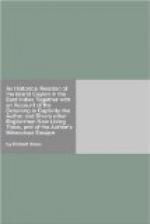Of their Birds, Fish, Serpents, Commodities.
[Their Birds.] In the next place I will entertain you with some relation of the other living Creatures among them. I begin with their Birds. In that Land there are Crowes, Sparrowes, Tom-titts, Snipes, just like these in England, Wood-Pigeons also, but not great flocks of any sorts, as we have, onely of Crowes and Pigeons. I have seen there Birds just like Woodcocks and Partridges, but they are scarce. A great many wild Peacocks: small green Parrots, but not very good to talk. But here is another [Such as will be taught to speak.] Bird in their Language called Mal-cowda, which with teaching will speak excellently well. It is black with yellow gills about the bigness of a Black-Bird: And another sort there is of the same bigness, called Cau-cowda, yellow like gold, very beautiful to the eye, which also might be taught to speak.
[Such as are beautiful for colour.] Here are other sorts of small Birds, not much bigger than a Sparrow, very lovely to look on, but I think good for nothing else: some being in colour white like Snow, and their tayl about one foot in length, and their heads black like jet, with a tuft like a plume of Feathers standing upright thereon. There are others of the same sort onely differing in colour, being reddish like a ripe Orange, and on the head a Plume of black Feathers standing up. I suppose, one may be the Cock, and the other the Hen.
[A strange Bird.] Here is a sort of Bird they call Carlo, which never lighteth on the ground, but always sets on very high Trees. He is as big as a Swan, the colour black, the Legs very short, the Head monstrous, his Bill very long, a little rounding like a Hawks, and white on each side of the head, like ears: on the top of the crown groweth out a white thing, somewhat like to the comb of a Cock; commonly they keep four or five of them together; and always are hopping from bough to bough; They are seldom silent, but continually make a roaring noyse, somewhat like the quacking of a Duck, that they may be heard at least a mile off; the reason they thus cry, the Chingulayes say, is for Rain, that they may drink. The bodies of these Fowls are good to eat.
[Water-Fowls resembling Ducks and Swans.] Here is a sort of Bird very much resembling a Duck, but not very plentiful. And another sort of Fowl as big as a Duck, cole black, which liveth altogether upon Fish. It is admirable to see, how long they will remain under water, and at what a distance they will rise again. Besides these, there are many other kinds of Birds, much larger than Swans, which keep about the Ponds and Marshes to catch Fish, but the people eat them not: Nature hath endowed them with an admirable understanding, that they are not to be catched by the Allegators, tho there be many of them in those waters.
[Peacocks.] The Peacocks in rainy weather are sometimes hunted and caught by Dogs; for their Feathers being wet, they are uncapable of flying far.




